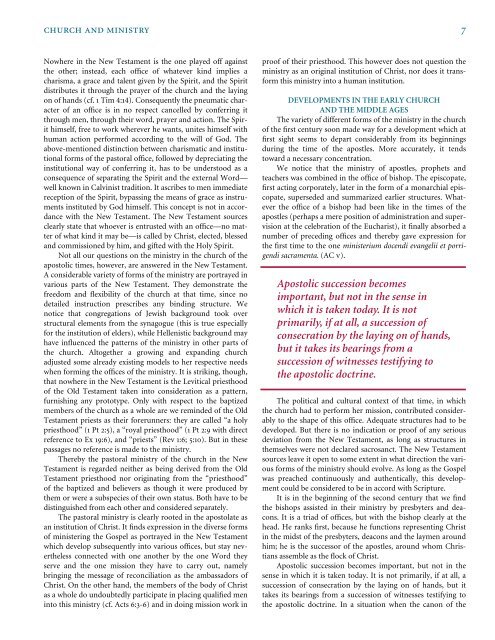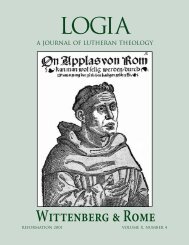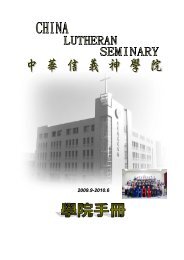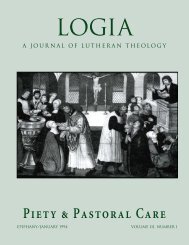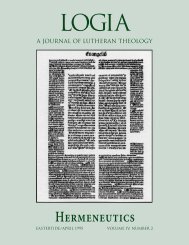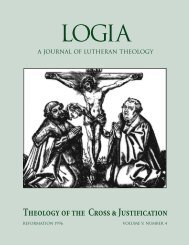Create successful ePaper yourself
Turn your PDF publications into a flip-book with our unique Google optimized e-Paper software.
church and ministry 7<br />
Nowhere in the New Testament is the one played off against<br />
the other; instead, each office of whatever kind implies a<br />
charisma, a grace and talent given by the Spirit, and the Spirit<br />
distributes it through the prayer of the church and the laying<br />
on of hands (cf. 1 Tim 4:14). Consequently the pneumatic character<br />
of an office is in no respect cancelled by conferring it<br />
through men, through their word, prayer and action. <strong>The</strong> Spirit<br />
himself, free to work wherever he wants, unites himself with<br />
human action performed according to the will of God. <strong>The</strong><br />
above-mentioned distinction between charismatic and institutional<br />
forms of the pastoral office, followed by depreciating the<br />
institutional way of conferring it, has to be understood as a<br />
consequence of separating the Spirit and the external Word—<br />
well known in Calvinist tradition. It ascribes to men immediate<br />
reception of the Spirit, bypassing the means of grace as instruments<br />
instituted by God himself. This concept is not in accordance<br />
with the New Testament. <strong>The</strong> New Testament sources<br />
clearly state that whoever is entrusted with an office—no matter<br />
of what kind it may be—is called by Christ, elected, blessed<br />
and commissioned by him, and gifted with the <strong>Holy</strong> Spirit.<br />
Not all our questions on the ministry in the church of the<br />
apostolic times, however, are answered in the New Testament.<br />
A considerable variety of forms of the ministry are portrayed in<br />
various parts of the New Testament. <strong>The</strong>y demonstrate the<br />
freedom and flexibility of the church at that time, since no<br />
detailed instruction prescribes any binding structure. We<br />
notice that congregations of Jewish background took over<br />
structural elements from the synagogue (this is true especially<br />
for the institution of elders), while Hellenistic background may<br />
have influenced the patterns of the ministry in other parts of<br />
the church. Altogether a growing and expanding church<br />
adjusted some already existing models to her respective needs<br />
when forming the offices of the ministry. It is striking, though,<br />
that nowhere in the New Testament is the Levitical priesthood<br />
of the Old Testament taken into consideration as a pattern,<br />
furnishing any prototype. Only with respect to the baptized<br />
members of the church as a whole are we reminded of the Old<br />
Testament priests as their forerunners: they are called “a holy<br />
priesthood” (1 Pt 2:5), a “royal priesthood” (1 Pt 2:9 with direct<br />
reference to Ex 19:6), and “priests” (Rev 1:6; 5:10). But in these<br />
passages no reference is made to the ministry.<br />
<strong>The</strong>reby the pastoral ministry of the church in the New<br />
Testament is regarded neither as being derived from the Old<br />
Testament priesthood nor originating from the “priesthood”<br />
of the baptized and believers as though it were produced by<br />
them or were a subspecies of their own status. Both have to be<br />
distinguished from each other and considered separately.<br />
<strong>The</strong> pastoral ministry is clearly rooted in the apostolate as<br />
an institution of Christ. It finds expression in the diverse forms<br />
of ministering the Gospel as portrayed in the New Testament<br />
which develop subsequently into various offices, but stay nevertheless<br />
connected with one another by the one Word they<br />
serve and the one mission they have to carry out, namely<br />
bringing the message of reconciliation as the ambassadors of<br />
Christ. On the other hand, the members of the body of Christ<br />
as a whole do undoubtedly participate in placing qualified men<br />
into this ministry (cf. Acts 6:3-6) and in doing mission work in<br />
proof of their priesthood. This however does not question the<br />
ministry as an original institution of Christ, nor does it transform<br />
this ministry into a human institution.<br />
DEVELOPMENTS IN THE EARLY CHURCH<br />
AND THE MIDDLE AGES<br />
<strong>The</strong> variety of different forms of the ministry in the church<br />
of the first century soon made way for a development which at<br />
first sight seems to depart considerably from its beginnings<br />
during the time of the apostles. More accurately, it tends<br />
toward a necessary concentration.<br />
We notice that the ministry of apostles, prophets and<br />
teachers was combined in the office of bishop. <strong>The</strong> episcopate,<br />
first acting corporately, later in the form of a monarchial episcopate,<br />
superseded and summarized earlier structures. Whatever<br />
the office of a bishop had been like in the times of the<br />
apostles (perhaps a mere position of administration and supervision<br />
at the celebration of the Eucharist), it finally absorbed a<br />
number of preceding offices and thereby gave expression for<br />
the first time to the one ministerium docendi evangelii et porrigendi<br />
sacramenta. (AC v).<br />
Apostolic succession becomes<br />
important, but not in the sense in<br />
which it is taken today. It is not<br />
primarily, if at all, a succession of<br />
consecration by the laying on of hands,<br />
but it takes its bearings from a<br />
succession of witnesses testifying to<br />
the apostolic doctrine.<br />
<strong>The</strong> political and cultural context of that time, in which<br />
the church had to perform her mission, contributed considerably<br />
to the shape of this office. Adequate structures had to be<br />
developed. But there is no indication or proof of any serious<br />
deviation from the New Testament, as long as structures in<br />
themselves were not declared sacrosanct. <strong>The</strong> New Testament<br />
sources leave it open to some extent in what direction the various<br />
forms of the ministry should evolve. As long as the Gospel<br />
was preached continuously and authentically, this development<br />
could be considered to be in accord with Scripture.<br />
It is in the beginning of the second century that we find<br />
the bishops assisted in their ministry by presbyters and deacons.<br />
It is a triad of offices, but with the bishop clearly at the<br />
head. He ranks first, because he functions representing Christ<br />
in the midst of the presbyters, deacons and the laymen around<br />
him; he is the successor of the apostles, around whom Christians<br />
assemble as the flock of Christ.<br />
Apostolic succession becomes important, but not in the<br />
sense in which it is taken today. It is not primarily, if at all, a<br />
succession of consecration by the laying on of hands, but it<br />
takes its bearings from a succession of witnesses testifying to<br />
the apostolic doctrine. In a situation when the canon of the


